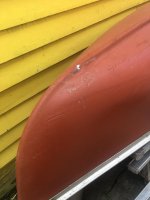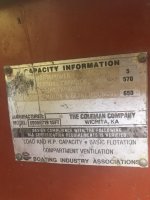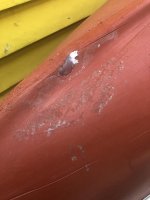Hi Gang,
First time poster, but excited to be here and learn more about tripping. Already impressed with some of the length of these trips!
Posting today seeking advice for repairs of an old Coleman canoe. This was on my uncle's farm, and went unused for many years before he gifted it to me a few years ago. When he gave it to me, it had a small (fingernail) size crack in the bow. When it's not plugged, water definitely leaks in. Since then, I've filled it with caulk/silicone, and that more or less keeps the water out, but doesn't seem like a very trust repair.
I'm not sure of the material of the canoe, and not sure how to check. That's why I've included the label here. Google searches tell me it's a Ram-X 15.
Any advice on how to fix this patch in a more permanent manner? I don't know of any repair shops anywhere near here (New Orleans, Louisiana).
Right now, I have two canoes (the other one is a Mad River), and don't really use both. I'm looking at selling one and purchasing a kayak, or trading a canoe for a kayak. Figured before I did that, I should try to get it fixed.
First time poster, but excited to be here and learn more about tripping. Already impressed with some of the length of these trips!
Posting today seeking advice for repairs of an old Coleman canoe. This was on my uncle's farm, and went unused for many years before he gifted it to me a few years ago. When he gave it to me, it had a small (fingernail) size crack in the bow. When it's not plugged, water definitely leaks in. Since then, I've filled it with caulk/silicone, and that more or less keeps the water out, but doesn't seem like a very trust repair.
I'm not sure of the material of the canoe, and not sure how to check. That's why I've included the label here. Google searches tell me it's a Ram-X 15.
Any advice on how to fix this patch in a more permanent manner? I don't know of any repair shops anywhere near here (New Orleans, Louisiana).
Right now, I have two canoes (the other one is a Mad River), and don't really use both. I'm looking at selling one and purchasing a kayak, or trading a canoe for a kayak. Figured before I did that, I should try to get it fixed.




